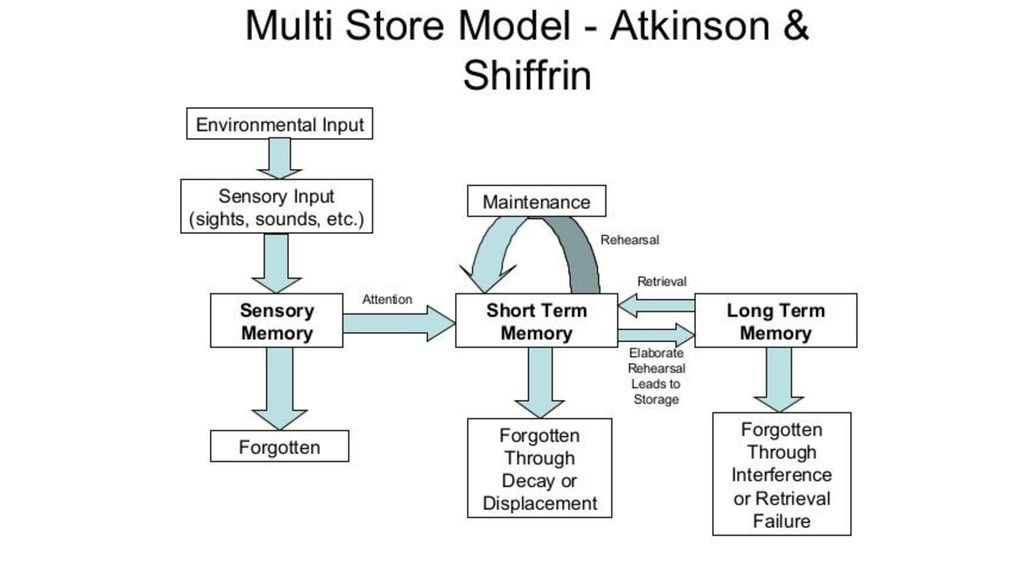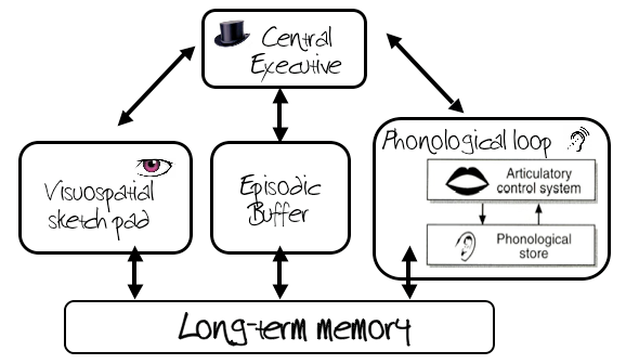Cognitive Psychology
1/15
Earn XP
Name | Mastery | Learn | Test | Matching | Spaced | Call with Kai |
|---|
No study sessions yet.
16 Terms
Evaluate one or more models of memory.
Multi Store Model:
HM (Milner, 1966) (Corkin, 1997)
Working Model of Memory:
Baddeley & Hitch (1974) - Quinn and McConnel (1996)

MSM - HM case study
Experienced a bicycle accident. Developed severe epilepsy. Dr Scoville removed parts of his brain in 1953. Anterograde amnesia.
Milner (1966)
- psychometric and cognitive tests, observation, interviews
- STM unaffected, but LTM afftected
- no episodic (event) or semantic (general knowledge) LTMs
- procedural memories intact
- MSM does not account for HM transferring procedural memories to long term store
Corkin (1997)
- MRI revealed hippocampus had most damage
- transfer of STM to LTM localised to hippocampus

WMM from Baddeley & Hitch (1974)
WMM proposed by Baddeley & Hitch in 1974. Dual task-technique. Different stores for auditory and visual processing: same store results in intereference.
Quinn & McConnell (1996)
Aim: find evidence for WMM
Procedure: participants learn list of words by imagery or rehearsal. IV: distractor noise. 1. no noise. 2. concurrent visual noise (changing patterns/dots). 3. concurrent verbal noise (speech in foreign language).
Findings: memory by imagery - affected by visual noise. memory by rehearsal - affected by verbal noise. So, separate store for different STMs.
Conclusion: Imagery processing uses Visuo-Spatial sketchpad. Verbal processing uses Phonological loop. If two tasks use same component, performance deteriorates.
Evaluate research into schema theory.
Bartlett (1932)
- (Bergman & Roedegger, 1999)
Anderson et al (1976)
Bartlett (1932) experiment
Aim: investigate how memory of unfamiliar story is affected by previous knowledge.
Procedure: Cam. Uni. students told native american folktale the War of the Ghosts. Repeated reproduction. Serial reproduction.
Findings: familiarised material - 'canoes' to 'boats'. 'paddling' to 'rowing'. Omission of information, 'ghosts' 'face become contorted' dropped. transposed details.
Conclusion: Memory is reconstructive. Remembering is active - info retrieved and changed to fit into schema.
CT:
strengths: important for the time. Ecological validity as we engage in remembering and repeating every day (but nonsense material used). Explains why people have different memories of events.
limitations: did not standardise intervals of time. Few controls, despite being an experiment. Attempted replications of the study have been unsuccessful. Details of participants unclear.
Bergman and Roedegger (1999) experiment
Replicated Bartlett's experiment.
Procedure: IV = 15 minute delay in retelling/no delay in retelling.
Findings: 15 minute delay meant more distortion in the story.
Anderson et al (1976)
Aim: to see how personal experiences and schemas influence interpretations of stories
Participants: 30 female students studying for a career in music education + 30 male physical education students
Procedure: 2 passages (150 words each) were given to the participants. Prison/wrestling passage = person escaping from prison, but can be interpreted as someone escaping a wrestling move. Cards/music passage = playing cards, but can be interpreted as playing musical instruments. 10 multi-choice questions asked with 2/4 answers correct. Free recall test. Autobiographical questionnaire (to develop understanding of their schema). Debriefing questionnaire to see if aware of alternative interpretations.
Findings: PE students got 64% correct answers on Prison/wrestling passage - music students 28%. Music students got 71% correct on Cards/music passage - PE students 29%. Analysis of free recall - PE students more likely to have wrestling and card interpretation, music students more likely to have prison and music interpretation. Analysis of autobiographical data - 62% participants said never thought of alternative interpretation. 20% became aware of alternative interpretation during multiple choice questions.
Conclusion: schemas affect our interpretation of stories.
CT: poor reading skills could affect interpretation ability. 62% aware of alternate interpretation - effect of schemas not the same for everyone? Differences of genders in the groups could be a confounding variable.
Evaluate one or more studies on reconstructive memory.
Shaw & Porter (2017)
Loftus and Palmer (1974)
Shaw and Porter (2017)
Aim: to investigate false memories and how they compare to true memories
Participants: 60 Canadian undergrads (43 female) in exchange for $50. Predominantly caucasian and native-English speaking. (5 not either).
Procedure: family-informant false storyline that took place aged 11-14 to convice young adults (who had highly emotional experience aged 11-14, reported by caregiver) they committed a crime. Told an examination of memory retrieval methods - interview room had books on it to increase credibility. 3X 40 minute interviews with 1 week interval. True event presented first, then false. Accurate cues from caregiver (names, age, city). Required to explain what happened in detailed.
Context recall, guided imagery, visualisation to help retrieval.
Irrefutable false evidence: 'In the questionaire your parents said...'. Social pressure: 'Most people are able to recall if they try hard enough'. Building rapport: 'How has your semester been?'. Using facilitators: 'Good.' Smiling, open-ended prompts.
Debrief - informed second memory false. How suprised? How suspicious of interviewer? Scale 1-7. Whether they believed false memory to be true.
Findings: False recollection high - 70% for criminal, 76.67% for non-criminal. 'Memories' richly detailed. False memories shared characteristics with true memories.
Conclusion: People can visualise and recall detailed false memories.
CT: deterministic - suggests all people will behave the same. Good internal and external validity - studies what it says it will, similar to real world false memories. Ethnocentric + hard to generalise.
Loftus and Palmer (1974)
Aim: To investigate whether leading questions asked of eyewitnesses after an event can change memory of that event.
Procedure:
Experiment 1 - 45 American university students were split into five groups and were shown seven film clips of traffic accidents. Following each film, participants were asked to write a brief account, and then to answer questions, one of which was the leading question: 'About how fast were the cars going when they hit each other?' Hit, smashed, collided, bumped, contacted. - different verb for different group.
Experiment 2, version 1 - 150 students divided into 3 groups. One film of car accident. Asked questions including leading question, but only with verbs 'hit' or 'smashed'. Control group did not have question on speed estimate.
Experiment 2, version 2 - 150 students divided into 3 groups, randomly allocated to condition. Asked questions including leading question, but only with verbs 'hit' or 'smashed'. Control group did not have question on speed estimate. Asked to come back a week later without re-watching video. 'Did you see any broken glass?' Yes or no.
Findings: 'Smashed' average 40.5mph. 'Contacted' average 31.8mph. Second variation more likely to recall seeing broken glass with verb 'smashed'. (Did you see any broken glass? Yes: smashed = 16 people, hit = 7 people.)
Conclusion: External information can change memory of an event. Schema processing could mean prior knowledge causes distortion.
CT: dependent variables controlled - able to establish cause-and-effect relationship. Procedure controlled so can be replicated - same video, same questions. Leading question hidden - demand characteristics lessened, but aware in an experiment so not completely controlled. WEIRD population. Lab experiment - low external validity.
Evaluate research into one bias in thinkng and decision making.
Illusory correlation:
Hamilton & Gifford (1976)
Lewis (1990)
CT: Ignores individual differences and experiences that could lead ro that correlation - may not be a bias in their thinking. Important real life applications in society.
Hamilton & Gifford (1976)
Illusory correlation - belief that two phenomena are connected when they are not.
Aim: to see if people associate negative traits to the minority group.
Procedure: Group A and group B - A twice as many people (26 vs 13). Both groups had to listen to statements about an individual in a group, one positive and one negative. Each group had same proportion of positive to negative statements to people. Then asked how many people in each group had positive vs negative traits.
Findings: they overestimated the number of negative traits in the minority groups.
Conclusion: because minority group smaller, their negative behaviours appeared more distinct.
CT: lacks ecological validity - used hypothetical statements. Only used 2 groups when there are typically more than 2 minority groups in the real world.
Lewis (1990)
Aim: to see how racial stereotyping may affect diagnosis and treatment
Participants: 139 psychologists from the 1985 Membership List of the Royal College of Psychiatrists.
Procedure: Participant were told the study was interested in attitudes to community care - real purpose not explained. Asked to make judgement on treatment for patient, and were required to predict whether criminal proceedings should be instigated. Some psychiatrists were told the patient was Afro-Caribbean, while others were told the patient was white. The symptoms were identical.
Findings: When the patient was described as black, the psychiatrists were more likely to recommend drug treatment, and saw the patient as more violent and criminal.
Conclusions: The psychiatrists made an illusory correlation. Treatment of disorders differs according to race.
CT: Old study - diagnosis has updated DSM and better training. More multi-cultural society - potentially less illusory correlations. Highly controlled the participants so could not be associated with years of experience.
Evaluate research into the influence of emotion on one cognitive process.
Brown & Kulik (1977)
Conway et al (1994)
Brown & Kulik (1977)
FBM was proposed by Brown and Kulik in 1977. Highly detailed, exceptionally vivid snapshot of a highly emotional event.
Aim: to investigate flashbulb memories
Participants: 80 American participants; 40 African American, 40 caucasian
Procedure: Questionnaire about 10 events, 9 very famous, public events, one of close personal relevance that involved a degree of shock. JFK, Malcolm X, Martin Luther King, George Wallace. 'Do you recall the circumstances in which you first heard that...?' When checked yes, asked to write a free recall.
Findings: 90% formbed FBMs for JFK's assassination, but more African Americans formed FBMs for MLK.
Conclusion: If there is not sufficient surprise, consequentiality or emotional arousal, then no flashbulb memory occurs.
CT: memory of the event may be due to confabulation or rehearsal with other people. Difficult to test and control as emotion is subjective and some things will be more important than others to an individual.
Conway et al (1994)
Aim: to investigate the formation of FBMs for learning the news of Margaret Thatcher's resignation as British Prime Minister.
Procedure: multi-national test-retest study.
Findings: Over 86% of UK subjects had FBMs 1 year after resignation - spontaneous, accurate, full recall, intricate details. Less than 29% of non-UK subjects had FBMs 1 year after resignation - forgetting, reconstructive errors, confabulatory responses. Formation of FBMs primarily associated with level of importance attached to event and level of active response to the news.
Conclusion: Supports Brown and Kulik (1977) in suggesting FBMs may constitute a class of autobiographical memories distinguished by preferential encoding.
CT: FBMs could be down to annual reinforcement/overt rehersal via the media rather than emotion.